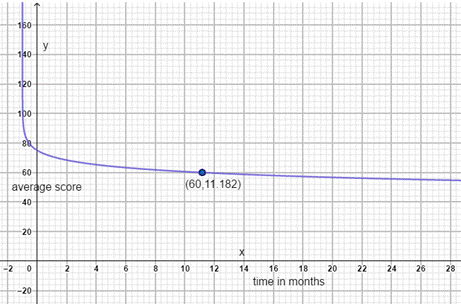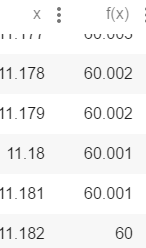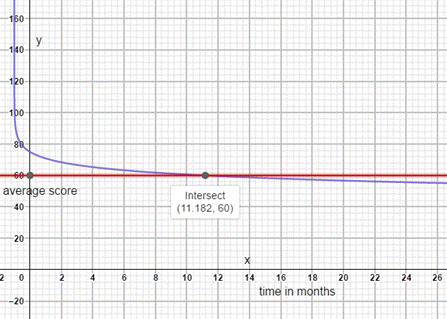
Concept explainers
To calculate: the number of months it would take for the average score in Example
Explain the method of solving the problem.
Describe another way to use the graphing utility to determine the answer.
Based on the shape of the graph, explain whether the rate at which a student forgets information increase or decrease with time.
Answer to Problem 128E
By using a graphing utility table feature, it can be concluded that in approximately
Another method to solve the problem is by graphing a line
Based on the shape of the graph, the rate at which students forgets information decreases, which may be due to consecutive retests.
Explanation of Solution
Given information:
Consider the information given in Example
The human memory model to determine the average score of the students every month after the exam:
Where t is the time in months.
As per the problem.
The function:
Use graphing utility to graph the function.
Step 1: Press WINDOW button to access the Window editor.
Step 2: Press
Step 3: Enter the expression,
Step 4: Press GRAPH button to graph the functions.

The table of values from the graph:

From the graph, it can be concluded that in approximately
Another method to solve the problem is by graphing a line

The graph shows the two lines intersect at
The function
Based on the shape of the graph, the rate at which students forgets information decreases, which may be due to consecutive retests.
Chapter 3 Solutions
PRECALCULUS W/LIMITS:GRAPH.APPROACH(HS)
 Calculus: Early TranscendentalsCalculusISBN:9781285741550Author:James StewartPublisher:Cengage Learning
Calculus: Early TranscendentalsCalculusISBN:9781285741550Author:James StewartPublisher:Cengage Learning Thomas' Calculus (14th Edition)CalculusISBN:9780134438986Author:Joel R. Hass, Christopher E. Heil, Maurice D. WeirPublisher:PEARSON
Thomas' Calculus (14th Edition)CalculusISBN:9780134438986Author:Joel R. Hass, Christopher E. Heil, Maurice D. WeirPublisher:PEARSON Calculus: Early Transcendentals (3rd Edition)CalculusISBN:9780134763644Author:William L. Briggs, Lyle Cochran, Bernard Gillett, Eric SchulzPublisher:PEARSON
Calculus: Early Transcendentals (3rd Edition)CalculusISBN:9780134763644Author:William L. Briggs, Lyle Cochran, Bernard Gillett, Eric SchulzPublisher:PEARSON Calculus: Early TranscendentalsCalculusISBN:9781319050740Author:Jon Rogawski, Colin Adams, Robert FranzosaPublisher:W. H. Freeman
Calculus: Early TranscendentalsCalculusISBN:9781319050740Author:Jon Rogawski, Colin Adams, Robert FranzosaPublisher:W. H. Freeman
 Calculus: Early Transcendental FunctionsCalculusISBN:9781337552516Author:Ron Larson, Bruce H. EdwardsPublisher:Cengage Learning
Calculus: Early Transcendental FunctionsCalculusISBN:9781337552516Author:Ron Larson, Bruce H. EdwardsPublisher:Cengage Learning





